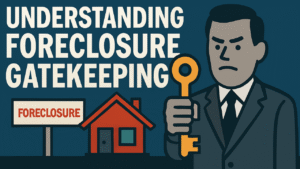 Understanding Foreclosure Gatekeeping: Barriers Homeowners Face During the Foreclosure Process
Understanding Foreclosure Gatekeeping: Barriers Homeowners Face During the Foreclosure Process
Foreclosure gatekeeping is a term used to describe the procedural, legal, and administrative obstacles that prevent or delay homeowners from accessing foreclosure prevention options. It often involves actions—or inactions—by lenders, loan servicers, or legal systems that create unfair barriers during the foreclosure process. These barriers can have devastating effects on families trying to save their homes.
In this blog post, we’ll explore what foreclosure gatekeeping is, how it occurs, real-world examples, and what homeowners can do to protect themselves. If you are facing foreclosure or looking to understand your rights, this guide will help you spot gatekeeping practices and take informed action.
What is Foreclosure Gatekeeping?
Foreclosure gatekeeping refers to any system, policy, or practice that restricts a homeowner’s ability to:
- Access mortgage assistance programs
- Apply for a loan modification
- Defend themselves in court
- Get accurate information about their foreclosure status
Gatekeeping can be intentional or systemic, but its effect is the same: it makes it harder for borrowers to stop or slow down foreclosure proceedings.
Common Examples of Foreclosure Gatekeeping
1. Loan Servicer Delays and “Document Cycling”
Many homeowners experience something known as “document cycling.” A borrower submits all required paperwork for a loan modification, but the servicer repeatedly claims that documents are missing or outdated—even if they were recently submitted.
Example:
A homeowner named Lisa applied for a mortgage modification through her bank. She submitted the requested forms three times, but each time she was told something new was missing. Meanwhile, the foreclosure process continued behind the scenes. By the time she sought legal help, the foreclosure sale was scheduled.
This tactic delays the review of loan assistance applications and makes it nearly impossible for the borrower to meet deadlines.
2. Lack of Communication and Transparency
Some servicers do not provide clear updates or written notices regarding foreclosure status or loss mitigation options. Borrowers may receive confusing or incomplete information, making it difficult to take timely action.
SEO Tip: Keywords like “loan modification denial,” “foreclosure notice not received,” and “missed foreclosure communication” can help users find this content.
3. Legal Gatekeeping in Non-Judicial States
In many U.S. states, foreclosures are non-judicial, meaning they don’t go through the court system. This speeds up the foreclosure process but limits homeowners’ ability to contest wrongful foreclosure actions.
Example:
In California, a borrower may lose their home through non-judicial foreclosure with minimal legal intervention. If the servicer failed to offer a legally required loan modification review, the borrower might not even know their rights were violated until it’s too late.
4. Intentional Misuse of Dual Tracking
Dual tracking occurs when a lender continues foreclosure proceedings while simultaneously reviewing a loan modification application. Federal law prohibits this practice under certain circumstances, but it still happens.
Example:
John applied for a loan modification and was told foreclosure would pause during the review. However, the lender still scheduled a foreclosure sale. John only found out when an eviction notice appeared on his door.
5. Discriminatory Practices or Neglect in Certain Communities
Studies show that Black and Hispanic homeowners are more likely to be targeted with aggressive foreclosure actions and less likely to be approved for loan modifications. This kind of gatekeeping stems from systemic inequalities in the housing and lending industries.
Why Foreclosure Gatekeeping Matters
Gatekeeping often pushes borrowers out of the system before they have a chance to access legitimate foreclosure prevention options. It results in:
- Increased wrongful foreclosures
- Higher rates of homelessness
- Widening racial and economic inequality
- Lost equity for homeowners
Foreclosure isn’t just a financial process; it affects families, communities, and future housing opportunities. When homeowners are blocked from saving their homes, everyone loses.
How Homeowners Can Fight Back
If you’re facing foreclosure, here are steps you can take to protect yourself against gatekeeping:
- Document Everything
Keep a record of every communication with your lender or servicer. Save emails, letters, and phone call logs. - Request Written Confirmations
Ask for all foreclosure or loan modification decisions in writing. This creates a paper trail if legal help is needed. - Contact a HUD-Approved Housing Counselor
These professionals offer free foreclosure assistance and can help you navigate the system. - Hire a Foreclosure Attorney
An experienced foreclosure lawyer can identify gatekeeping tactics and challenge them in court. - File a Complaint with the CFPB
The Consumer Financial Protection Bureau investigates loan servicer misconduct. Filing a complaint can prompt faster resolution. - Know Your State Laws
Foreclosure rules vary by state. Understanding whether you’re in a judicial or non-judicial foreclosure state is crucial.
Final Thoughts: Breaking the Gatekeeping Barrier
Foreclosure gatekeeping is a serious issue that strips homeowners of their rights and destabilizes communities. Whether it’s through delayed paperwork, legal loopholes, or outright misinformation, the goal is often to speed up foreclosure while slowing down your ability to fight it.
If you’re in foreclosure or at risk, knowledge is your most powerful tool. Understand the warning signs, seek help early, and don’t be afraid to challenge unfair practices.